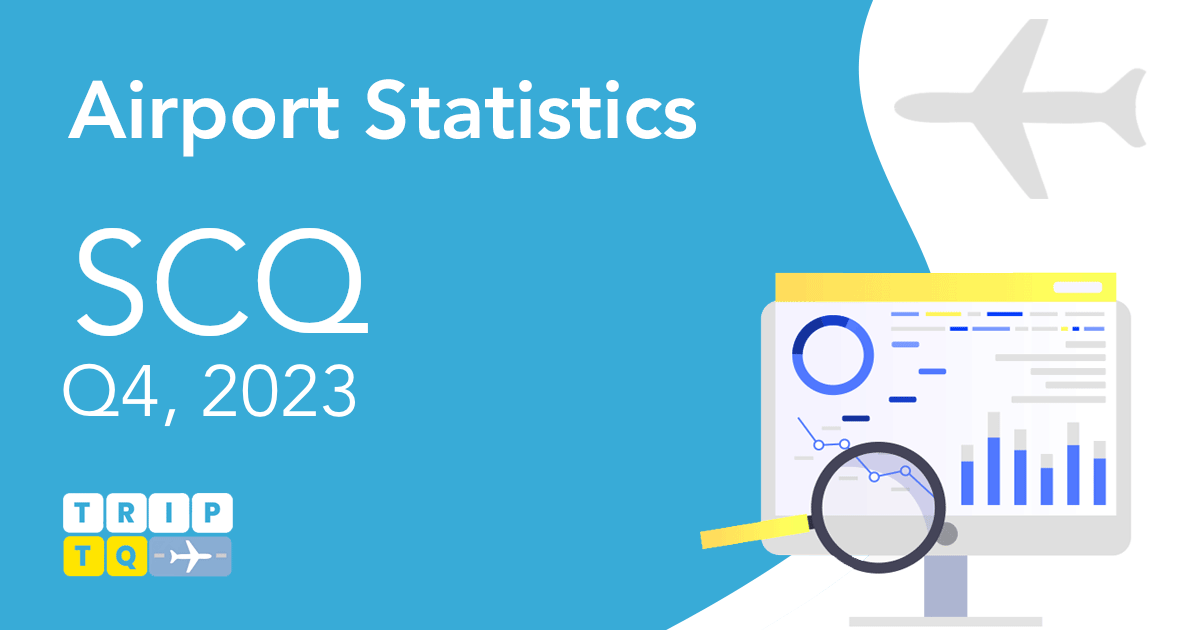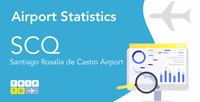SANTIAGO ROSALÍA DE CASTRO AIRPORT (SCQ) INFORMATION
| Origin | Airline | Flight no. | Scheduled | Est./Actual | Status |
|---|---|---|---|---|---|
|
...
|
|||||
| Destination | Airline | Flight no. | Scheduled | Est./Actual | Status |
|---|---|---|---|---|---|
|
...
|
|||||
![car-icon]() Car Hire at Santiago Rosalía de Castro Airport
Car Hire at Santiago Rosalía de Castro Airport




Santiago Airport - All Information on Santiago Airport (SCQ)


Santiago Rosalía de Castro Airport
Lavacolla S/N, 15820 Santiago de Compostela, A Coruña, SpainFacts and History about Santiago Rosalía de Castro Airport

Santiago Airport (SCQ), often known as Santiago de Compostela Airport or just Santiago, is an international airport serving the historical region of Galicia, Spain.
It is in the town of Lavacolla and approximately 12 kilometers away from Santiago de Compostela.
It is the only target city for Ryanair in Northern Spain and serves as the hub for Vueling's operations northwest of the Iberian Peninsula. The Christian Camino de Santiago pilgrimage path passes through the area not far from the airport.
The airport only has one terminal. The previous terminal at Santiago de Compostela Airport opened for business in 1969 and has undergone several expansions since then. On October 13, 2011, the activities were moved to the new terminal, which resulted in the old terminal being shut down.
On October 14, 2011, the Santiago de Compostela Airport formally opened its new terminal. It extends across an area that is 74,000 square meters in size and is located right next to the previous terminal. It contains thirteen gates, 22 check-in counters, four baggage carousels, and three security checkpoints. Of the thirteen gates, five have airbridges.
The luggage hall is divided into two sections: one for flights departing from Schengen and the other for flights outside Schengen. It can process up to 4 million passengers every year.
The Autovàl A-54 connects the airport with Santiago de Compostela, located 13 kilometers away. In addition to linking the airport with Lugo (94.5 km), where it will connect with the Autova A-6 (which provides toll-free motorway access to the rest of Spain) and the Autova A-8 (which connects with the Autova A-6 at Lugo), this highway will also eventually lead to the French border.
The airport is directly connected to the nearby Autopista AP-9, which provides access to A Corua (66 kilometers away), Ferrol (88 kilometers away), Pontevedra (75 kilometers away), Vigo (100 kilometers away), and the border with Portugal. Through the Autopista AP-53, which links up with the Autopista AP-9, you may get to Ourense, located 116 kilometers away.
At the airport, you can choose from several reputable automobile rental providers. The new terminal building at the airport features more than 5,000 covered parking spots that can be used either temporarily or permanently. In addition, several reasonably priced private parking lots are available for extended stays in the vicinity of the airport.
History of Santiago Airport
In October 1932, a group interested in aviation established the airport. Two months later, directors were chosen to determine where the airport would be built.
In 1935, construction work began on the airport. Exactly two years later, in September 1937, the city of Santiago de Compostela saw its first regularly scheduled flight take off from its airport. Following the conclusion of the Spanish Civil War, political prisoners were made to labor in the construction of the airport.
The year 1969 saw the construction of a brand-new terminal at the airport. Later, it had several extensions and a rebuild in 1993.
In June of 1980, Iberia established a seasonal connection to New York City, the first transatlantic route departing from Santiago de Compostela. The carrier flew the Boeing 747 planes used for the journey.
After another four months, Viasa began offering non-stop service to Caracas using McDonnell Douglas DC-10 aircraft. In 1981, a cargo terminal was constructed at the airport, which enabled it to accommodate flights carrying cargo.
Avensa reopened the service to Caracas in 1999 after the previous carrier, Viasa, had gone out of business in 1997. On October 13, 2011, a new terminal specifically for passengers was inaugurated at the airport.
About Santiago de Compostela, Spain
The city of Santiago de Compostela serves as the administrative center of the autonomous community of Galicia, which is located in the northwest corner of Spain.
Since the 9th century, the shrine of Saint James the Great, which is now the Cathedral of Santiago de Compostela, has served as the final stop on the Way of St. James, the most popular route for Catholic pilgrims. The city's historic district was included on the UNESCO World Heritage Sites list in 1985.
Because of its proximity to the predominant winds from low-pressure systems in the Atlantic Ocean, Santiago de Compostela has considerable rainfall throughout the winter months and a very mild climate for its latitude.
Santiago is the local Galician adaptation of the Vulgar Latin name "Saint James." It originally referred to the apostle James. It is said that the term Compostela originates from the Latin phrase Campus Stellae, which translates to "field of the star."
However, it is highly improbable that this phrase could have evolved into the modern form of Compostela through the typical translation process from Latin to Medieval Galician.
Other hypotheses propose that the name originates from the Latin word compositum, the local Vulgar Latin word composita tella, both of which indicate "burial ground," or simply from the Latin word compositella, which means "the well-composed one."
This toponym is also used for a few other locations in Galicia, such as Compostilla in the province of León.
Although it is still strongly dependent on public administration (Santiago is home to the headquarters of Galicia's autonomous government), cultural tourism, industry, and higher education through its university, the economy of Santiago is becoming increasingly diversified.
New businesses have been formed in a variety of different sectors, including the transformation of timber (FINSA), the automobile industry (UROVESA), and telecommunications and electronics (Blusens and Televés).
The headquarters of Banco Gallego, a financial institution that Novacaixagalicia owns, can be found downtown.
Because of the Camino de Santiago, tourism is a significant industry, particularly during the years leading up to Holy Compostela (when July 25 falls on a Sunday).
After the significant investments made by the Xunta and the enormously successful advertising campaign, it ran for the Holy Year of 1993. After that, the number of pilgrims who completed the journey progressively increased.
During the Holy Year of 2010, more than 272,000 pilgrims journeyed. When the feast of Saint James returns to its usual position of falling on a Sunday, the following Holy Year will not occur again after 2010. Even when Holy Years are not taking place, the city is visited by a significant number of pilgrims.
Weather in Santiago, Spain
The summers of Santiago de Compostela are mild and almost always clear. At the same time, the winters are brisk, damp, and partially cloudy. The temperature rarely drops below 32 degrees Fahrenheit or climbs above 87 degrees Fahrenheit annually and ranges from 41 to 76 degrees.
Towards the end of June to the beginning of September is the most acceptable time of year to visit Santiago de Compostela for outdoor activities that require pleasant weather.
The warm season begins on June 21 and continues until September 20, with an average daily high temperature above 71 degrees Fahrenheit. August is the hottest month in Santiago de Compostela, with an average high temperature between 76- and 57 degrees Fahrenheit.
During the chilly season, which begins on November 17 and continues until March 7, the average daily high temperature is below 57 degrees Fahrenheit.
January is the coldest in Santiago de Compostela, with lows of 41 degrees Fahrenheit and highs of 53 degrees Fahrenheit.
The likelihood of having a day that is cloudy or rainy in Santiago de Compostela changes significantly throughout the year.
Greater than a 27% chance of precipitation falling on any given day occurs during the wetter season, which begins on September 28 and continues until May 27.
November typically sees the most precipitation in Santiago de Compostela, with an average of 13 days of rainfall during the month.
The dry season lasts for four months, beginning on May 27 and ending on September 28. In Santiago de Compostela, July averages only four days of precipitation.
When referring to days with precipitation, we differentiate between those that just have rain, those that only have snow, and those with rain and snow. November is the month of Santiago de Compostela, with an average of 13 days of rain.
According to this classification, rain is the most common type of precipitation that occurs throughout the year, with the chance of rain reaching its highest point on January 8.
Even though the temperature may drop at night, a humid day is generally followed by a muggy night because the dew point tends to vary more slowly than the temperature does. It means that even if the temperature may drop at night, a muggy day is typically followed by a muggy night.
Transfer Services at Santiago Airport
There are multiple options for ground transportation at Santiago Airport. The Arrivals Hall features a taxi stand, a bus station, and many vehicle rental firms.
Trains operating from the close-by Santiago de Compostela Railway Station also provide high-speed rail service to the airport.
The airport in Santiago is one of the busiest in Spain. Millions of people use this terminal each year to various destinations. Because of the constant influx and outflow of visitors, finding reliable ground transportation services can be a challenge.
Some things to think about while making your choice are listed below.
- The price tag is arguably one of the most crucial considerations. There are many different means of transportation to choose from, so shop around before making a final decision.
- Schedules should also be remembered. If you're in a rush, pick a mode of transportation that won't keep you waiting too long to arrive.
- When deciding on a ground transportation service, it's crucial to consider how far your final destination is.
- Long-distance trips call for more comfortable transportation, so consider hiring a private car service or cab.
Rental Car Services at Santiago Airport
You'll find a wide selection of car rental agencies at Santiago Airport. The terminal building is home to vehicle rental counters operated by Avis, Budget, Europcar, Hertz, and many more. See and compare all rental car companies at Santiago Airport.
Now let's say you've decided to rent a car in Santiago de Compostela. Then you should plan and make a reservation. This will guarantee the lowest pricing and a car waiting for you when you arrive.
Rideshare Services at Santiago Airport
At Santiago Airport, you can now use a rideshare service. Airport-goers may now use their phones to arrange for a taxi to their final destination with this brand-new service. This is a practical and inexpensive alternative for individuals who prefer not to use public transit or rent a car.
Taxi Services at Santiago Airport
The airport serves Santiago de Compostela in northwest Spain. Taxi service to and from the airport is provided. Several taxi services are available at the airport, so you may pick the one that best fits your needs. See more information about taxis at Santiago Airport.
Train Services at Santiago Airport
Multiple bus routes travel between the train station near downtown and the airport in Santiago. There are direct trains to most of the important cities in Spain, including Madrid. You can take one of several regional trains from the airport to reach other cities and towns in Galicia. More information about train services at Santiago Airport.
Bus Services at Santiago Airport
Getting from the airport to the downtown area and the bus/train station is accessible, thanks to the city bus service. Long-distance and international services depart directly from Santiago de Compostela to most Galician cities and towns. This includes A Corua, Ferrol, Lugo, Ourense, Pontevedra, and Vigo.
The airport is served by three regional routes that lead to A Corua and Lugo and the A Maria coastal section of Lugo. More information about buses to and from Santiago Airport.
Hotel Shuttle Services at Santiago Airport
Shuttles run between the airport and local hotels in Santiago. Anyone who has a ticket and can prove their identity can use this service. Booking the shuttle service is possible both online and at the airport desk. Please contact the hotel directly to determine how much the shuttle service will cost you per person.
Parking Services at Santiago Airport
All kinds of parking options are available at Santiago Airport. There are two alternatives for long-term parking and several places reserved for people with disabilities. We have parking spots for both the short and long term. Passengers with impairments have access to reserved parking places. See more information about short and long term parking at Santiago Airport.
Other Services at Santiago Airport
Several international airlines and regional and low-cost carriers provide passenger services at Santiago Airport. It is located in the municipality of Lavacolla, just over 12 kilometers from the city center.
The airport has one terminal building which handles both domestic and international flights. It is well connected to the city center by public transportation, with buses and taxis readily available.
The airport has all the necessary facilities for passengers, including check-in counters and security checkpoints. Many shops and restaurants are available before or after going through customs.
There is also a baggage claim area for passengers to collect their luggage after arriving at the airport.
Wi-Fi at Santiago Airport
Santiago Airport offers free Wi-Fi for all passengers. The airport has several access points, providing a high-speed and stable connection. Whether you need to stay connected for work or want to kill time before your flight, the airport's Wi-Fi will keep you connected. Choose the "AIRPORT FREE WIFI AENA" network.
ATMs at Santiago Airport
Suppose you need to get your hands on some cash while at Santiago Airport. There are a few ATMs located throughout the terminal. You can find them near the check-in counters, in the departure lounge, and outside the security area.
Currency Exchange at Santiago Airport
Santiago Airport offers passengers various currency exchange options. There are several ATMs located throughout the airport, as well as a full-service bank.
There are several kiosks in the main terminal area for those looking to exchange their currency before departing on their flight. These kiosks offer competitive rates and can accommodate most major currencies.
Nursing Mothers Station at Santiago Airport
Santiago Airport nursing mothers' station is a great place for moms to stop and breastfeed or pump while waiting for their flights. The station includes comfortable chairs, a sink, and a changing table.
Restrooms at Santiago Airport
Santiago Airport have several toilets located throughout the facility. These restrooms are clean and well-maintained, providing travelers with a comfortable place to take care of their personal needs.
The airport also has a family restroom, perfect for families traveling with small children. This room has a changing table, sink, and toilet, making it easy for parents to take care of their little ones.
Food and Beverages at Santiago Airport
The airport offers travelers a wide range of food and beverage options. There are several restaurants, cafes, and bars located throughout the terminal. Whether you're looking for a quick snack or a sit-down meal, you'll be able to find something to suit your needs. If you're looking for something specific, ask one of the airport staff members. They'll be happy to point you in the right direction.
Shopping at Santiago Airport
This airport in Santiago de Compostela is a great place to shop for souvenirs and gifts. Many shops sell traditional Spanish items, and plenty of duty-free stores. The prices are very reasonable, and the selection is excellent. Whether you are looking for something specific or just browsing, you are sure to find what you need at the airport.
Smoking at Santiago Airport
Smoking is not permitted in any indoor airport area. This includes all shops, restaurants, and bars. There are designated smoking areas outside the terminal building.
Lost and Found Section at Santiago Airport
Suppose you have lost an item while at the airport. Please check with the Lost and Found section. The office is located on the ground floor. You can also call (+34) 913 21 10 00.
Ticketing Services at Santiago Airport
The airport offers various services to make your travel experience more comfortable. Among these services is the ticketing service, which allows you to purchase your tickets in advance and avoid long queues at the airport.
Information Desk at Santiago Airport
The information desk at Santiago Airport is staffed by knowledgeable and helpful individuals who can provide travelers with a wealth of information about the airport, its facilities, and the surrounding area. The desk is located in the main terminal near the entrance to the departures area and is open 24 hours a day.
Pet Relief at Santiago Airport
The pet relief area is located in the public area of the airport and is available to all passengers with pets. It is equipped with waste bags, a water bowl, and a grassy area for your pet to relieve themselves.
Baggage Claim at Santiago Airport
Santiago Airport has four baggage claim areas on the ground floor. If you are unsure which area to go to, please ask a staff member or look at the departure board for your flight.
Disabled Passengers at Santiago Airport
Santiago Airport offers excellent facilities for disabled passengers. The airport has special parking spaces for disabled people and lifts and ramps to make it easy to get around the terminal. There are also dedicated toilets and plenty of staff to help with any needs.
Useful Contact Details
Santiago Airport is located in the northwestern Spanish region of Galicia, about 12 kilometers from the city center. The airport offers direct flights to destinations across Europe, North Africa, and many local destinations.
If you're planning on traveling to Santiago de Compostela Airport for the first time, here are a few tips to keep in mind:
- Check the flight status before heading to the airport.
- When going through security, have your passport and boarding pass ready.
- There are a variety of shops and restaurants available at Santiago Airport, so if you have time before your flight departs, feel free to explore them.
In case of a medical or police emergency in Santiago de Compostela, Spain, you should call 112. This is the number for emergency services in Spain.
Hospitals
Address: Rúa Choupana s/n, Santiago de Compostela, 15706, A Coruña
Phone: 981 950 000
Sanatorio Nuestra Señora de la Esperanza (Hospital HM La Esperanza)
Address: Calle de las Burgas, 2, 15705 Santiago de Compostela, La Coruña
Phone: 981 552 200
Police
Policía Autonómica de Galicia
Address: Rúa de Roma, 17, 15707 Santiago de Compostela, A Coruña, Spain
Coordinates: 42.8863611372949, -8.522696053760537
Santiago Airport Contacts
Address: Lavacolla S/N, 15820 Santiago de Compostela, A Coruña, Spain
General Phone: +34 913 21 10 00
Lost and Found Phone: +34 913 21 10 00
Information Desk: +34 913 21 10 00
Official website: https://www.aena.es/en/santiago-rosalia-de-castro.html
Local Information
Drive on: Right
Electricity: 230V/50Hz.
Plug: F
Currency: Euro, €
Wi-Fi at Airport: Free Wi-Fi is available at Santiago Airport. Please connect to the “AIRPORT FREE WIFI AENA” network.
Services at Santiago Rosalía de Castro Airport
- airplanemode_activeFlights
- drive_etaCar Hire
- airport_shuttleAirport Transfers
- local_parkingParking
- local_hotelHotels
Useful Information about Santiago Rosalía de Castro Airport

Passenger Traffic at Santiago Airport Booms in Q4 2023, Surpassing Pre-Pandemic Numbers by 1.27%
View...
Santiago Rosalía de Castro Airport has seen a remarkable rise in passenger numbers over the past few years. The passenger traffic increased by 16.33%, from 208,565 in December 2019 to 242,630 in December 2023.
View...
Santiago Rosalía de Castro Airport's passenger traffic surged 28.2% in October 2023 compared to pre-pandemic levels.
View...
Santiago Rosalía de Castro Airport has had a remarkable recovery. In September 2023, this hub recorded a 21.67% increase in passenger numbers compared to the same month in the pre-pandemic year of 2019...
View...